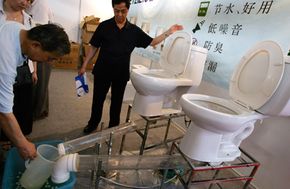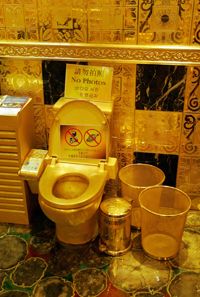If everyone in the United States flushed the toilet at the same time, sewer systems across the country would be overwhelmed with wastewater.
Nov. 19 is World Toilet Day, a time to reflect upon how far modern sanitation has come. In the United States in 2005, less than half of one percent of the country's more than 124 million households didn't have a flushing toilet [source: U.S. Census Bureau]. In comparison, 71 percent of India's total population of more than one billion people had no access to a toilet that same year. There were an estimated 350 million public and private toilets in the United States by the mid-1990s [source: Flushmate] -- a lot of toilets by anyone's measure. So what would happen if everyone in the United States decided to flush their toilets at the same time in celebration of World Toilet Day?
Advertisement
Since as far as we could find out -- no one's ever tried it before -- we can't say for certain exactly what would happen. But we can take a pretty good guess: "It would be ugly," says Steve Cox, one wastewater treatment facility operator we interviewed.
The average home in America is outfitted with sewer pipes around four inches in diameter. The pipes from your home are connected to subdivision systems, which connect together at street systems. Street systems tie into road systems, which go to main road systems, and, ultimately, waste treatment plants. Underneath your town is a wastewater system as complex as a spider's web.
The closer you get to the treatment plant, the larger the inside diameter of the pipes becomes. So a four-inch pipe from your house connects to a 12-inch pipe and so on, until -- in larger cities -- pipes may be almost 10 feet in diameter. A pipe this size can hold a lot of water, but can it hold enough for everyone to flush at once?
If everyone in each of Milwaukee, Wisconsin's 330,584 households all flushed just one toilet at the same time, and each of those toilets expelled 3.5 gallons per flush, then Milwaukee's sewer system would suddenly be inundated with 1,157,044 gallons of wastewater [source: NexTag]. Even with the city's new 108-inch pipes, this could be a problem, and we're not even counting all of the public toilets in the city.
Of course, the earth isn't level underneath many cities, and to overcome changes in elevation, sewer systems use lift stations, wastewater plants that push sewage uphill toward its final treatment destination. These stations would be the first overwhelmed by unanimous flushing. There would simply be too much wastewater trying to pass through the pipes at the same time -- kind of like trying to force an orange through a drinking straw -- and the flow of sewage would stop. Sewage already past the lift stations would return downhill, and as the lift stations flooded, the lines leading to them would back up.
Eventually this sewage would find its way to the place where this whole debacle originated -- your home. Backflow valves probably wouldn't help. Not only would your toilet overflow, but so, too, would every wastewater line in your home, including your shower, kitchen and bathroom sinks, and even your dishwasher and washing machine.
Outside, the manhole covers dotting the street would also flood and overflow, leaving people in sewage possibly more than ankle deep. Depending on how many people live in your city and how large the sewer pipes are, it could be even worse.
But with low-flow toilets, this scenario wouldn't be quite so bad.
Advertisement


